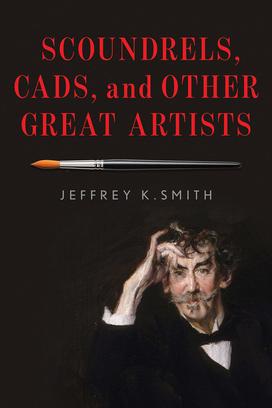Jeffrey Smith ’72 Depicts Famous Artists’ Unscrupulous Lives

In delving into the debauchery of many famous painters and other visual artists, Jeffrey K. Smith ’72 questions how much we ought to consider the life of an artist when considering their works, asking to what extent it matters if artists engage in unacceptable behavior as long as they produce stunning work.

Opening lines: Walk into almost any art museum and you are likely to find works created by individuals who engaged in unacceptable, even inexcusable behavior. As a visitor to the museum, you may be unaware of an artist’s past, but it is highly unlikely that the curator in the museum is. With some very famous artists, such as Picasso, the misdeeds are widely known. The simple fact is that when contemplating art, we typically either ignore the artist’s past or forgive it; or perhaps we even revel in it.
If you spend a significant portion of your life researching behavior in art museums, as my wife and I have, you occasionally take the opportunity to get close enough to visitors to hear what they are saying. In the course of decades of eavesdropping on people in museums, we have never heard words spoken such as the following: “That murderer could really depict the pathos and anguish of a martyr’s death.” “For a bigot, he was exceptionally good at revealing the tragedy of the plight of the Native American.” “Yes, he disowned his children, but just look at that sunset.”
Exploring a work of art involves the viewer and the work. Nothing else has to come into play, but more can be considered if the viewer chooses. One can read the label accompanying the work (if there is one), or study the artist, the era, or the style of the painting either before going to the museum, or after the visit is over. Note that in the discussion of The Third of May, there was nothing about Goya the person, whereas in Back View, all of the discussion was about Guston, the person. Cézanne was a mix of the work and the artist. And in all honesty, one can view David without knowing anything about the work or Michelangelo. It is overwhelming all on its own.
But what about artists who were awful people? Do we ignore their lives when we look at their art? Do we forgive them their transgressions and focus on their works? Or do the scandalous pasts of these artists add spice to the viewing of their works? My colleagues and I have conducted research on this question and found that knowing about an artist made a work more interesting than not knowing, whether that information was salacious or just normal biographical information. But to a degree, it depended on just how salacious the information was. In our research, we found that being a boastful, grandstanding, philandering degenerate was not really much of a problem for our participants. Murder did not appear too upsetting, either. On the other hand, they did seem to object to selling one’s wife to a brothel.
Is it the case that when artists, especially those of the past, have engaged in behavior we would find objectionable today, we tend to try to understand their misdeeds and to put their art in the context of their passionate personalities? Is the street brawler better able to depict violence? Does the serial womanizer portray romance more passionately? Does the disregard for the norms, rules, and even values of society lead an artist to more easily discard convention in art and break new aesthetic ground? Are artists “natural-born rebels” whose behavior we tolerate because we value their artistic contributions? As we examine the lives of nine artists in the pages to follow, my hope is that you will come to an understanding of some of these issues that is satisfactory to you. My take on these matters is unsettled, and at times unsettling.
Review: “As a scholar of creativity who is passionate about art, I am often frustrated by mythologized portraits of creative artists my students encounter as they explore creativity. I was pleased to see there’s not a boring, cardboard-cutout profile in this entire book! Jeff Smith tells the stories of these highly creative people in captivating prose that makes the stories come alive. More to the point, he also shares plentiful insights into the psychology of art and the creative process while entertaining us. I will never view art or artists the same way again!”
-- Jonathan Plucker, Julian C. Stanley Professor of Talent Development, Johns Hopkins University











No responses yet